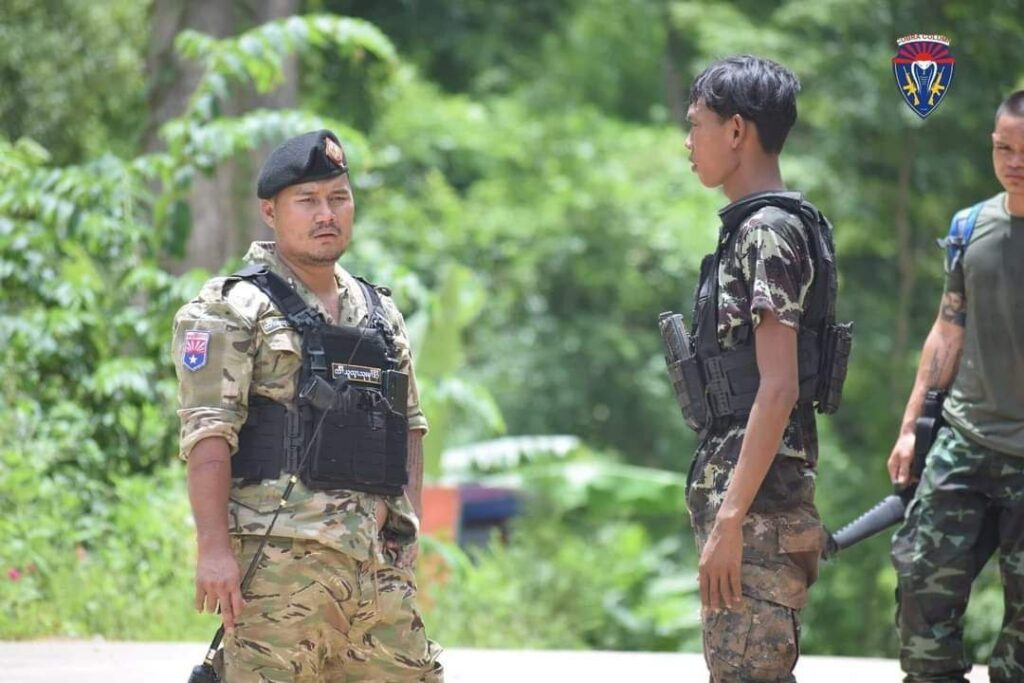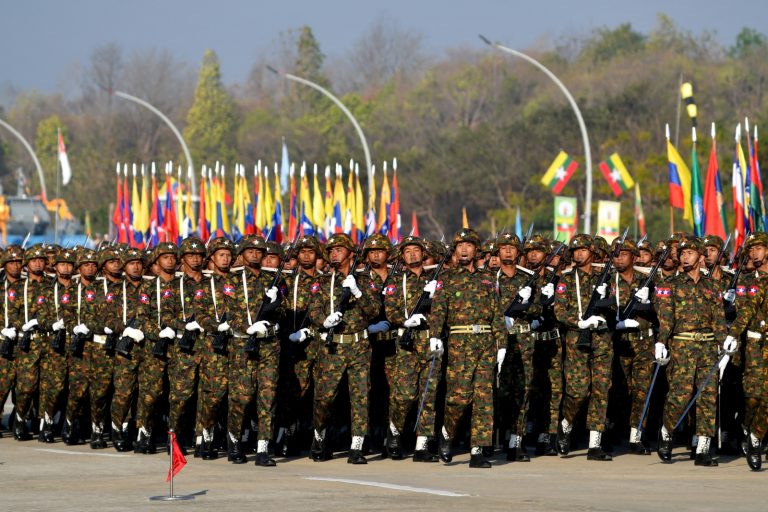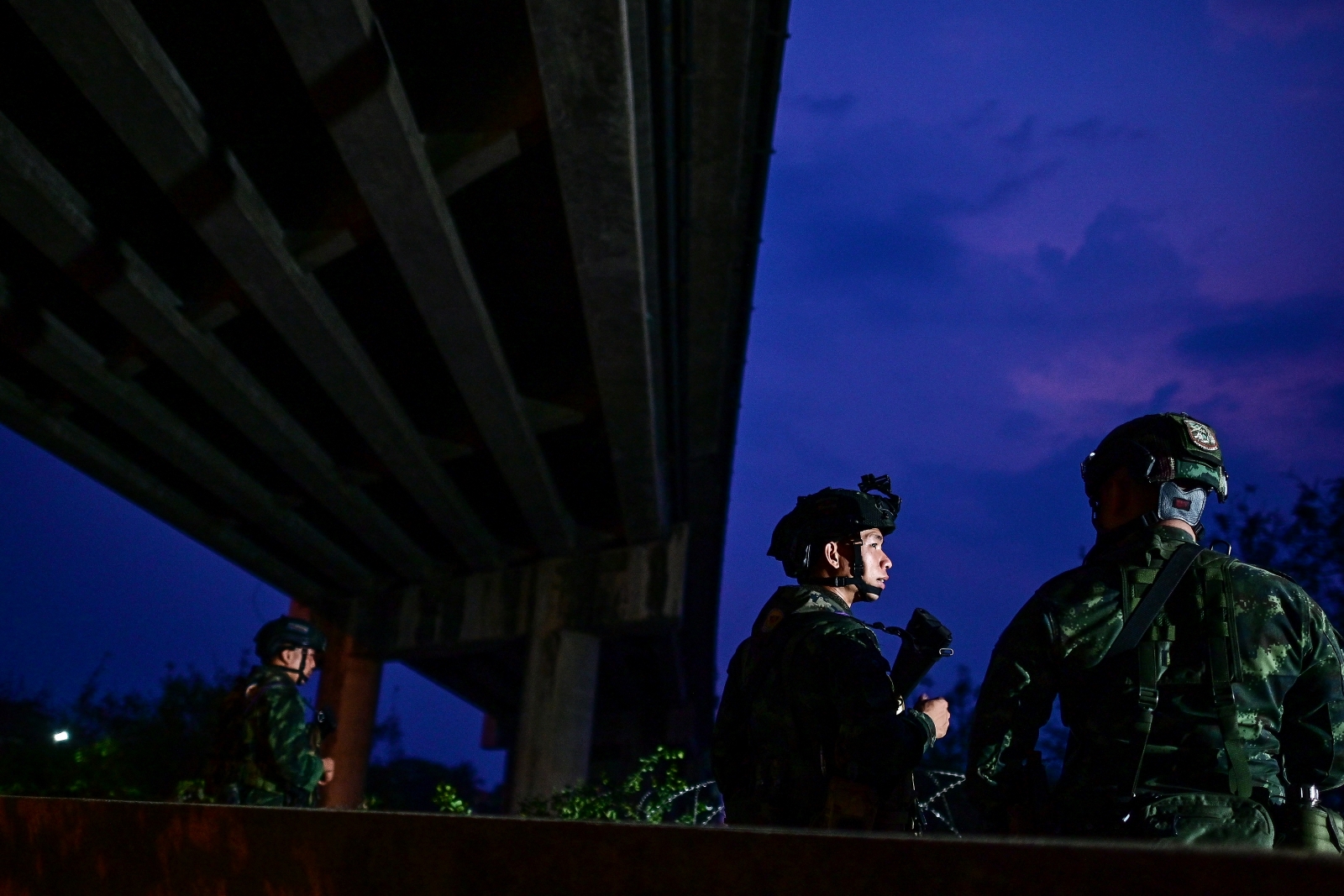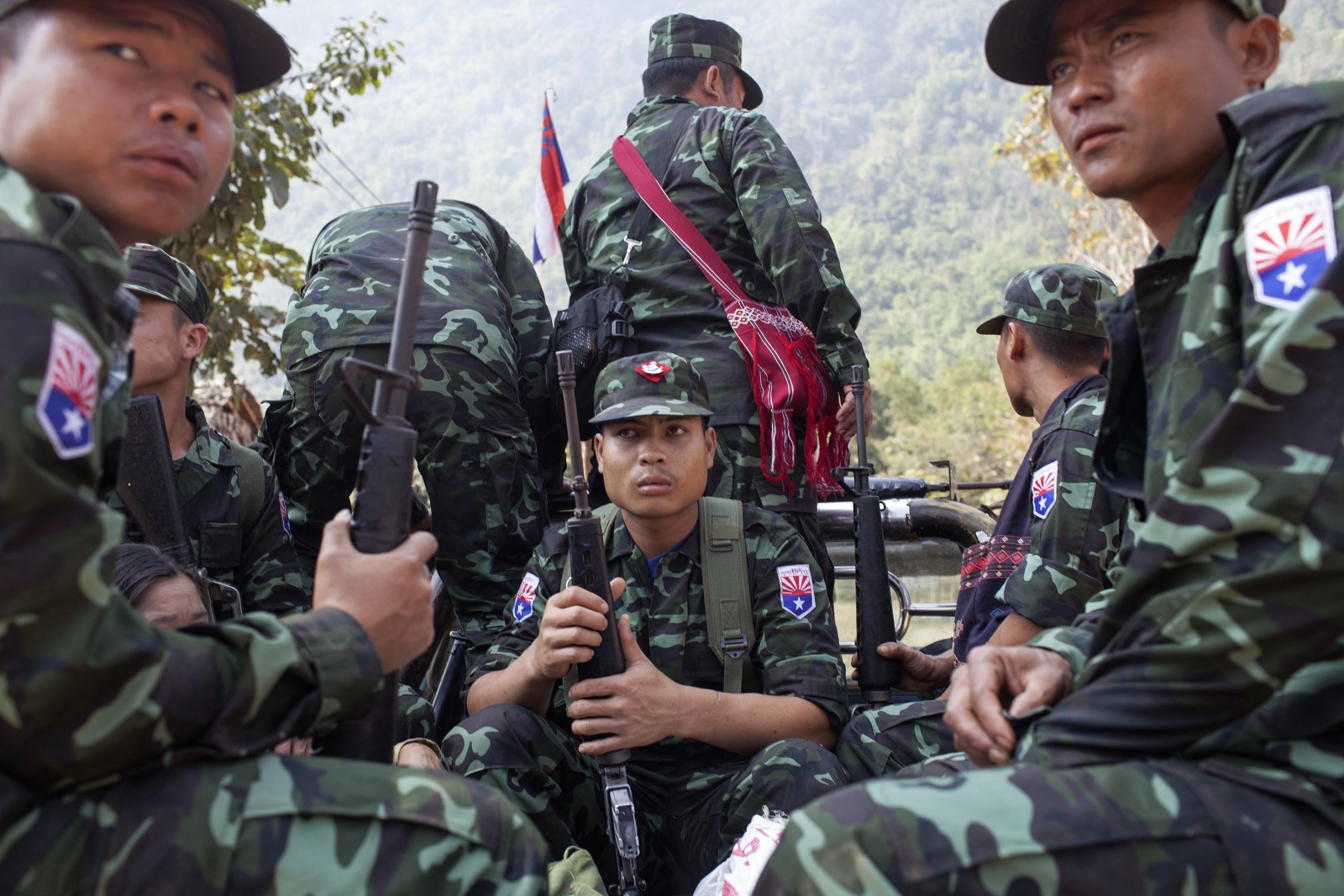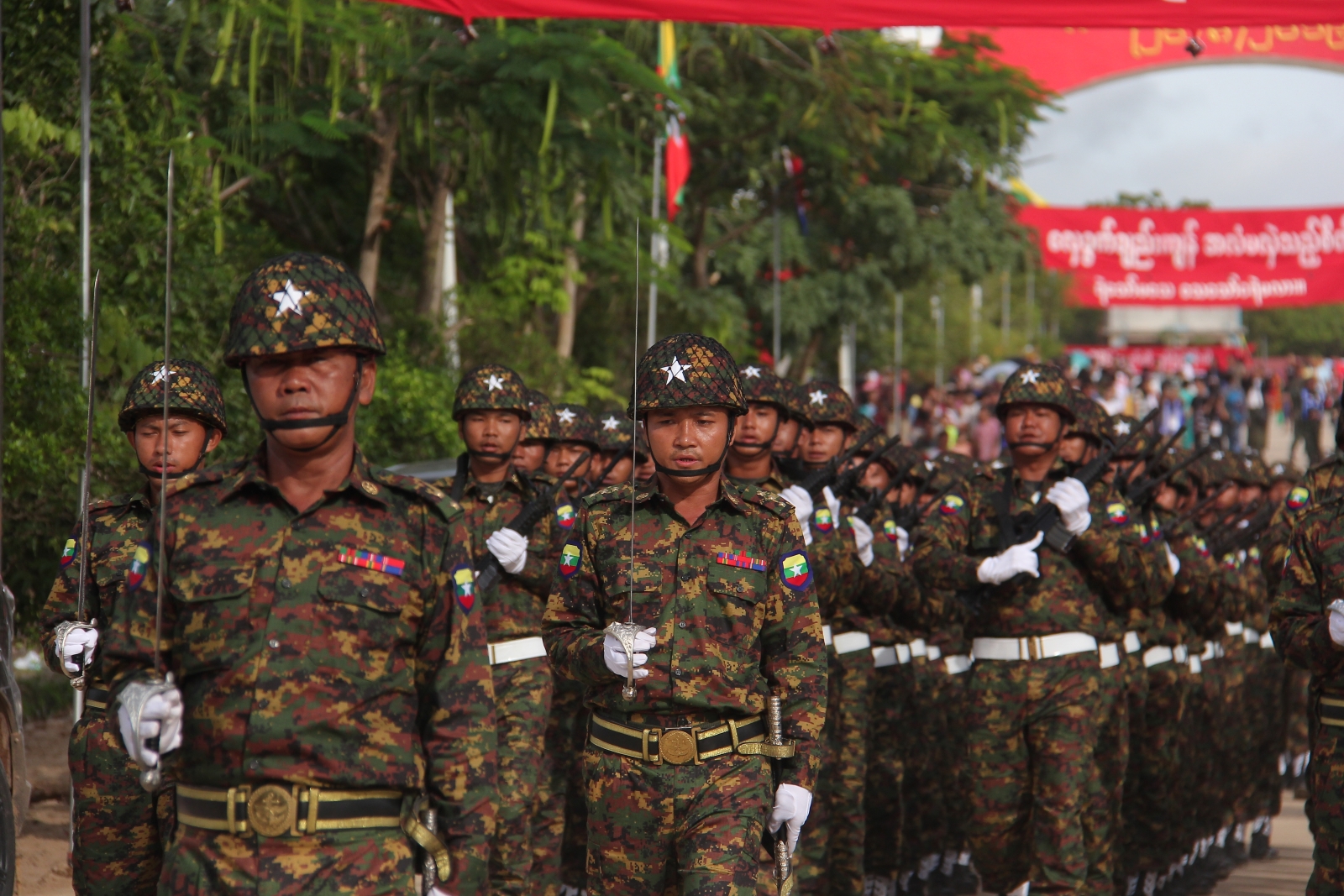After the coup, the Karen National Union was inundated with eager new pro-democracy fighters. While there were challenges in managing the recruits, and their expectations, sources on both sides say they’ve worked out the kinks.
By FRONTIER
When Ko Pon Nya* made the decision to leave Yangon more than a year ago and take up arms against the military, he initially wanted to go north to Sagaing Region, a resistance stronghold in the Bamar heartland. But the challenges seemed insurmountable so instead he, like many others, found his way to Kayin State.
“At that time, there was no formal system for new recruits in the north so it was really hard to find people who could help me. It was also a long distance and it seemed riskier to travel all the way to Sagaing from Yangon. So, after a while, I started looking closer to home and found that it was much easier to connect with people in Kayin State,” Pon Nya told Frontier by phone in early January.
Shortly after the military seized power in February 2021, the Karen National Union, one of Myanmar’s largest and oldest ethnic armed organisations, formed several committees to organise resistance to the new junta and created channels through which individuals like Pon Nya could travel to Kayin State, where the KNU is headquartered.
Pon Nya now serves as a warrant officer in the White Tiger Column, one of eight columns operating under a joint command between the shadow administration of the National Unity Government and the Karen National Liberation Army, one of the armed wings of the KNU. The NUG is a parallel government appointed by lawmakers elected in the 2020 polls, which the military refused to recognise.
Initially, the rapid influx of inexperienced fighters into KNU territory created challenges for the EAO, but in the last year the two groups have come together in one of the more promising examples of anti-junta cooperation.
Early tensions
In the months following the coup, hordes of people – some fleeing violence and others looking to fight the military – left their homes to seek refuge with the KNU.
For many, it was their first time in Kayin State and their first time holding a gun. Colonel Padoh Saw Yan Naing, commander of KNLA Battalion 27, which has been at the forefront of training the recruits, sat down with Frontier in November and said that managing the People’s Defence Force fighters – the new resistance fighters under the NUG – initially posed many challenges.
“There were so many difficulties in managing these young fighters when they first came to the forest because they did not have a good understanding of the country’s politics or our ethnic politics. The Karen people have been fighting against the military for 70 years, we are exhausted, but these boys didn’t understand this,” Yan Naing told Frontier.
“All they had inside of them was rage. They were so consumed with wanting to fight, but they had no long-term goal; when we asked them what they wanted to do after they defeated the dictatorship, they had no answer.”
While for many people in Myanmar the crackdowns on the 2021 anti-coup protests were their first exposure to the military’s violence, the KNU has been fighting against the Tatmadaw for autonomy for decades. A bilateral ceasefire in 2012 and the Nationwide Ceasefire Agreement in 2015 offered moments of peace, but any progress disappeared following the coup, with the KNU accusing the military of having “nullified all principles enshrined in the NCA”.
Despite the KNU’s long history of clashing with the Tatmadaw and its experience on the battlefield, many of the newly minted fighters were initially unwilling to listen to the ethnic soldiers.
“At the beginning, we had different ideas about how to fight. For example, whenever we would lose fighters in battle, the PDF guys usually wanted to push forward to avenge their deaths, but the KNLA leaders would tell us to retreat so that more lives weren’t lost,” Ma Shwe Yee Phoo*, a frontline medical officer from the Cobra Column, another one of the eight joint-command columns, told Frontier by phone in January.
“While this caused some tension, over time we have all learned that you need to be tactical, and by retreating when the stakes get high, you can lower the risk.”
The discord also extended beyond the battlefield to everyday activities like deciding on what to eat and how to dress, and overflowed into nearby communities that resented the stream of outsiders, according to Ko Soe Moe, an officer in the Red Dragon Column, another of the eight joint-command columns, who also spoke to Frontier by phone in January.
“At the beginning the fighters only had one goal, to kill the enemy, which created tensions with some of the communities that didn’t want violence on their doorsteps. But now we’re working more closely with these communities to build stronger relationships. For example, we will help them with their harvest and work with them to repair their roads,” said Soe Moe.
Lessons from the past
Part of the KNU’s strategy in managing the new fighters is driven by its unwillingness to repeat past mistakes.
Following the previous military coup in 1988, students formed the All Burma Students’ Democratic Front, an armed group dedicated to overthrowing the military. The ABSDF operated in Kayin and Kachin states, and received training and weapons from the KNU and Kachin Independence Army, but was largely left to its own devices. This proved to be a disastrous arrangement for both sides.
The ABSDF never came close to replicating the battlefield success of today’s PDFs, and eventually devolved into paranoid internal massacres. For the EAOs, they felt that after a few years of supporting and training them, most of their student allies quickly gave up the cause.
“In 1988, a lot of people came to the KNU and formed their own groups,” explained Padoh Saw Taw Nee, the KNU’s foreign secretary and spokesperson, during an in-person interview in November. “The KNU gave resources to everyone but then after the situation was resolved, these people abandoned us. So, this time, we have learned our lesson. These people aren’t allowed to form their own organisations; they can stay here but they are under the chain of command of the KNLA.”
In line with this new strategy, after the 2021 coup, the KNU decided to streamline the new recruits by putting one of its newest battalions, Battalion 27 in Brigade 6, in charge of managing them. The KNU split the new recruits into two groups, offering short-term military training for those who wished to go back to their hometowns or other cities, and long-term training for those who wanted to stay in KNU territory.
As the two groupings crystallised and the NUG forged a stronger alliance with the KNLA, the eight columns were created under the Joint 2 Committee, a joint command between the shadow government and the EAO. The first column, Daw Na, was formed on March 8 last year and the other seven columns, the Cobra Column, the White Tiger Column, the Red Dragon Column, the White Dragon Column, the Black Leopard Column, Gallon and Taung Nyo, followed shortly after.
How fighters were divided among these columns doesn’t appear to always be consistent – Shwe Yee Phoo had to take an intelligence placement test, while Soe Moe was able to simply pick which commander he wanted to serve under.
In other ethnic areas, the NUG’s uses its C3C committee – which includes the Chin National Front, KIA, Karenni Army, and ABSDF – to forge alliances with armed forces and consolidate administrative control over the country.
In Kayin, the J2C consists of five leaders from the KNU and another five from the NUG that work collaboratively. However, the responsibilities are clearly divided.
“Under the J2C, for military strategy, there’s a Joint Operation Command, which is led by two KNLA soldiers and one PDF fighter, but everything that happens in battle is overseen by the KNLA. The NUG will sometimes pitch us ideas, but they really only handle the administrative side of things,” explained Yan Naing.
U Naing Htoo Aung, secretary at the NUG’s Ministry of Defence, confirmed to Frontier that “the KNLA takes the lead in the military commands and the NUG oversees the administration and operations”.
The chain of command is also clear to those on the ground fighting. All eight columns have a commander from the KNLA and a deputy commander from the PDF. While the two sides work together, there is no question that the KNLA is the one calling the shots.
“When we are fighting, we each have our strengths: the KNLA is good with mapping because they know the region and the PDFs are good with pitching creative strategies,” said Shwe Yee Phoo, the Cobra Column medic. “But as far as I’m concerned, we are under the KNLA, and I only listen to our KNLA commander. I know that he sometimes gets orders from his superiors, but we don’t hear anything from the NUG.”
Pon Nya and Soe Moe said there’s a similar structure in their respective columns. While many of the PDF fighters said they feel a closer connection to the KNLA than the NUG at the moment, Yan Naing said he doesn’t expect this to be a permanent arrangement.
“After talking with the PDF fighters, it doesn’t seem like these young people want to be soldiers forever, so there’s a good chance that most of these people will eventually return to their old lives. For fighters who do want to keep fighting, I think it’s more likely that they will join the NUG’s federal army, but will maintain a strong alliance with the KNLA,” he said.

Lingering problems
While the new system has become a success story of resistance cooperation, there was initially pushback from members of the KNU leadership, and some disagreements remain.
KNU chairman Padoh Saw Mutu Say Poe repeatedly spoke out against armed uprising, instead advocating for dialogue with the military in line with the NCA. He remains the nominal leader of the KNU today, largely because the group has been unable to hold a long awaited congress and election, but increasingly resembles a lame duck with limited power and influence.
In March last year he attended an NCA conference but an official, who spoke on the condition of anonymity, told Frontier that he did not participate in his capacity as chairperson. Then, earlier this month, he was accused of betraying the Karen people by sending his daughter to accept an honorary title from junta leader Senior General Min Aung Hlaing.
Padoh Saw Shwe Maung, former chairman of the KNU’s Dooplaya District, also known as Kawkareik District, where KNLA Brigade 6 operates, was even more adamantly anti-PDF. At one point he instructed his subordinates “not to accept PDF fighters” in their territory. Finding himself out of step with his comrades, he left his post in February last year.
But Yan Naing maintains that the majority of the KNU leadership don’t share these sentiments and have been in favour of training the new fighters.
“Saw Shwe Maung believed that the armed revolution couldn’t be won. He believed in the NCA and believed that the situation could be resolved peacefully by talking, but he was alone in his beliefs so eventually he resigned,” said Yan Naing.
“Ultimately, we didn’t really have a choice but to accept these people. They had nowhere else to go. The decision was twofold: from a humanitarian standpoint we wanted to offer them sanctuary, and from a military standpoint, we didn’t want to waste the human resources of having more fighters.”
That’s not to say there are no more disagreements today. Yan Naing said the KNLA still sometimes must reprimand PDF fighters for “showing off on social media”. He said some post battlefield updates online, both to “be popular” and to secure more funding. “But they are sacrificing their security and their ability to fight the military,” he warned.
Taw Nee, the KNU’s spokesperson, told Frontier that the NUG’s engagement strategy often misleads the public, which could create problems for the resistance. He accused the NUG of “raising expectations” through unrealistic claims about their finances and territorial control, which could lead people to lose trust when the parallel government is unable to follow through.
Naing Htoo Aung, from the NUG’s defence ministry, said “there may be individual posts of PDF soldiers and their supporters that spread around social media, which may lead to misinterpretation and raise somewhat false hopes and expectations, including those related to finances and territorial gains”. However, he maintained that the NUG is working to motivate “our people with the reality of the revolution instead of misrepresenting the reality”.
The NUG had at one point claimed to control 50 percent of the country.
In recent weeks, there has also been a crisis between the PDFs and the Karen National Defence Organisation, another armed wing under the KNU that operates in a separate chain of command adjacent to the KNLA. The KNDO has seen far more controversy since the coup than the KNLA.
Commanders that oversaw massacres of civilians and prisoners of war split from the KNDO rather than be subject to a KNU investigation, but even without them, problems persist. Last month, the Pakokku PDF, which is based in Magway Region, accused the KNDO of killing three of its members and stealing weapons they had purchased to distribute in Magway.
For now, both the KNU and the PDF seem intent on finding an amicable solution. Taw Nee confirmed to Frontier that the KNU has arrested two alleged perpetrators in relation to the incident. A spokesperson for Pakokku PDF, who asked to remain anonymous due to security concerns, also told Frontier that they reported the incident to the NUG’s defence ministry, which is “working to take action” in cooperation with the KNU to “manage the issue”.
Despite these continued squabbles, all sources on both sides say the two groups are more united than ever before.
“Sometimes there are still different ways of thinking, but ultimately we all have the same goals, so things work themselves out,” said Shwe Yee Phoo. “Now we have become even closer than a family because when you go into battle with people you need to trust them with your life. As long as the Cobra Column exists and as long as there’s a dictatorship I will continue to fight.”


